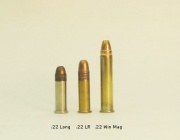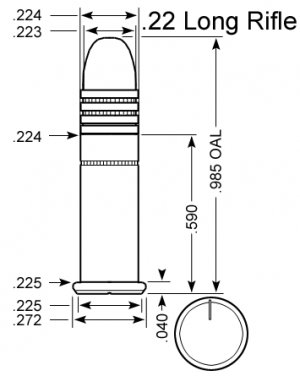Difference between revisions of ".22 Long Rifle"
m (1 revision) |
Latest revision as of 14:23, 15 March 2013
| .22 Long Rifle | ||||||||||||||||
|---|---|---|---|---|---|---|---|---|---|---|---|---|---|---|---|---|
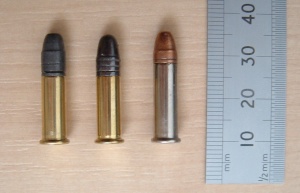
| ||||||||||||||||
| .22 Long Rifle - Subsonic Hollowpoint (Left), Standard Velocity (Center), Hyper-Velocity "Stinger" Hollowpoint (Right). | ||||||||||||||||
| Type | Rimfire cartridge | |||||||||||||||
| Country of Origin | United States | |||||||||||||||
| Specifications | ||||||||||||||||
| Parent Case | .22 long | |||||||||||||||
| Case Type | Rimmed, Straight | |||||||||||||||
| Bullet Ø | .223 in (5.7 mm) | |||||||||||||||
| Neck Ø | .225 in (5.7 mm) | |||||||||||||||
| Base Ø | .275 in (7.0 mm) | |||||||||||||||
| Rim Ø | .275 in (7.0 mm) | |||||||||||||||
| Rim Thickness | .040 in (1.0 mm) | |||||||||||||||
| Case Length | .590 in (15.0 mm) | |||||||||||||||
| Full Length | .985 in (25.0 mm) | |||||||||||||||
| Rifling twist | 406 mm (1 in 16") (see below) | |||||||||||||||
| Primer | Rimfire | |||||||||||||||
| Production & Service | ||||||||||||||||
| Designer | J. Stevens Arm & Tool Company | |||||||||||||||
| Design Date | 1887 | |||||||||||||||
| Manufacturer | everybody | |||||||||||||||
| Production Dates | 1888-present | |||||||||||||||
| In Service | n/a | |||||||||||||||
| Used By | civilians | |||||||||||||||
| Wars | n/a | |||||||||||||||
| Ballistic Performance Sampling | ||||||||||||||||
| ||||||||||||||||
Contents |
[edit] Popularity
The low cost, minimal recoil, and low noise make the .22 LR an ideal cartridge for recreational shooting, pest control, and it is often purchased in bulk. The standard box of .22 LR contains 50 rounds, and .22 LR is often sold by the brick, containing 10 boxes for 500 rounds, or the case containing 10 bricks for 5,000 rounds.
.22 LR ammunition is available in a very wide variety, and a very wide price range. Bullet weights range from 30 to 60 grains (1.9 to 3.9 g), velocities from 350–1,750 feet per second (110–530 meters per second). "Promotional" loads for plinking can be found for under US$20.00 per brick ($0.04 per cartridge), while precision target rounds can cost US$80.00 to upwards of US$250.00 per brick. Currently, a standard box of 50 rounds goes for US$2–3. For comparison, a box of 9x19 mm Parabellum, another popular and relatively inexpensive round for semi-automatic handguns, costs closer to US$12–35 per box of 50. It is common to shoot well over a hundred rounds on a single shooting range visit, and savings add up quickly. For rifle shooting, the price difference is even more dramatic as powerful rifle cartridges like .308 Winchester and .30-06 Springfield can approach and exceed US$1 per cartridge. For this reason especially, .22 LR is commonly used by hunters for off-season target practice.
The low recoil and high speed of a .22 LR cartridge in pistols make it suitable for introductory firearms courses. Because errors in technique are not covered up by the increased recoil of a "defense-caliber" handgun, they can be more easily identified and corrected before moving to more powerful handgun cartridges like 9 mm, .38 Special/.357 Magnum, or 45 Auto.
Annual production is estimated at 2–2.5 billion rounds.[2] [3]
[edit] Performance
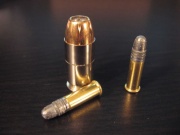
.22 LR is effective within 150 meters (490 ft). After 150 meters the ballistics of the round are such that the large "drop" will be difficult to compensate. The relatively short effective range, low report, and light recoil has made it a favorite for use as a target practice cartridge. The accuracy of the cartridge is good, but not exceptional; various cartridges are capable of the same or better accuracy. A contributing factor in rifles is the transition of even a high-velocity cartridge projectile from supersonic to subsonic within 100 yards (91 m). As the bullet slows, the shock wave caused by supersonic travel overtakes the bullet and can disrupt its flight path, causing minor but measurable inaccuracy.
The trajectory of the standard high-velocity .22 LR with a 40-grain (2.6 g) bullet has a 2.7-inch (69 mm) rise at 50 yards, and 10.8 inches (270 mm) at 150 yards, when zeroed for 100 yards (69 mm rise at 46 meters, and 274 mm at 137 meters, when zeroed for 91 meters).[4] A .22 LR rifle needs to be zeroed for 75 yards (69 m) to avoid over-shooting small animals like squirrels at intermediate distances.[4] The newest commercial rimfire, the .17 Mach 2, is based on the .22 LR case, but is slightly stretched in length (case length is similar to the CCI Stinger) and necked down. The light, aerodynamic .17 caliber (4.5 mm) bullet gives a much higher velocity than the .22 LR, for similar energy and a much flatter trajectory, but at the expense of increased cost and noise.
As a hunting cartridge, the .22 LR is mainly used to kill small vermin such as rats and squirrels. It is also highly effective on rabbits at distances closer than 150 yards (140 m) and on ground hogs, marmots, and foxes closer than 80 yards (70 m). It has been successfully used on large creatures such as coyotes, but range should be limited to no farther than 65 yards (59 m); head and chest shots are mandatory with the most powerful .22 cartridge the hunter can use accurately. Hunters should find which cartridges, out of the various high-velocity and hyper-velocity ones, shoot well for them by preliminary testing. For greater range or larger game, a more powerful cartridge should be used to ensure a clean kill. Examples include larger rimfire rounds such as the .22 WMR, .17 HMR, or any centerfire cartridge.
A .22 LR bullet is relatively underpowered when compared to larger cartridges, but dangerous nonetheless: it can easily kill or severely injure humans and large animals[2][3]. Users should therefore take great care to ensure there is no possibility of a stray bullet flying beyond its intended target and hitting someone or something else. Even after flying 400 yards (370 m), a stray .22 bullet is still traveling at approximately 500 feet (150 m) per second, which can inflict a very serious wound, and a standard .22 cartridge can have a ballistic range of up to a mile and a half (2400 m) if fired into the air.
[edit] Variants
There are a variety of different types of .22 LR loads. They are often divided into four distinct categories, based on nominal velocity:
- Subsonic, which also includes "target" or "match" loads, at nominal speeds below 1100 feet (335 m) per second.
- Standard-velocity: 1120–1135 feet (340–345 meters) per second.
- High-velocity: 1200–1310 feet (365–400 meters) per second.
- Hyper-velocity, or Ultra-velocity: over 1400 feet (425 m) per second.
[edit] Subsonic

- see also: The transonic problem
Subsonic rounds have a muzzle velocity of 330 meters (1080 ft) per second or less. These rounds are sometimes equipped with an extra heavy bullets of 46–61 grain (2.9–3.9 gram) to improve the terminal ballistics of the slower projectile. Conversely, the rounds can contain little more than primer and an extra-light bullet.
Subsonic rounds are favored because of slightly superior accuracy and reduction in noise. Supersonic rounds produce a loud crack which can scare away animals when hunting. Accuracy is improved with subsonic rounds, because any supersonic bullet (or projectile) that slows down from supersonic to subsonic speed undergoes drastic aerodynamic changes in this transonic zone that might adversely effect the stability and accuracy of the bullet.
Because the speed of sound in air at 68 °F (20 °C) is approximately 1126 feet (343.4 m) per second, the subsonic round's muzzle velocity is close to the speed of sound, or only very slightly below it, under many hunting conditions. However, under cold air conditions at 32 °F (0 °C), the speed of sound drops to 331.5 meters (1088 ft) per second, essentially the same speed as the muzzle velocity of what was otherwise a subsonic round. Hence, a "subsonic" round used in those kinds of temperatures would no longer actually be subsonic, and when its speed passes from supersonic to subsonic, it may become unstable, reducing accuracy. To counteract this, some cartridge manufacturers have lowered the speed of their subsonic ammunition to 1030 feet (315 m) per second, or significantly less, while other manufacturers still sell subsonic ammunition with a velocity only slightly less than 1082 feet (330 m) per second.
Some subsonic rounds do not work well in most semi-automatic .22 LR firearms, often failing to cycle the action because there's not enough recoil energy. Other subsonic rounds use heavier bullets that achieve lower velocities in order to ensure that, with a more massive bullet, there is enough energy to cycle any common blowback action. An example of this is the Aguila .22 LR "Sniper" round, which has a 60-grain (3.9 g) bullet. However, this can cause other problems: the more massive bullet of the Aguila cartridge, being longer, requires a tighter barrel twist (by the Greenhill formula) to ensure that the bullet remains stable in flight.
[edit] Standard velocity
Standard velocity rounds have a slightly supersonic muzzle velocity of around 1125 feet (340 m) per second, and a "normal" bullet weight of 40 grains (2.5 grams). Standard velocity cartridges generate near or slightly-supersonic velocities. These rounds generally do not develop these velocities in handguns because the short barrel does not take full advantage of the slower powder. The downside to supersonic rounds is that the bullet often drops to subsonic speeds on its way to the target which can degrade accuracy. The extra power and penetration, however, more than make up for the slight loss in accuracy for applications such as small game hunting.
[edit] High velocity
Many .22 LR cartridges use bullets lighter than the standard 40 grains (2.5 grams), fired at even higher velocities. Hyper-velocity bullets usually weigh around 30 grains (1.9 grams) and can have a muzzle velocity of 1400–1800 feet (425–550 meters) per second. This velocity is partially because of the of the use of lighter bullets.
The CCI Stinger was the first "hyper velocity" .22 LR cartridge, and provides a significant increase in velocity over standard .22 LR rounds. The Stinger uses a longer case, a stronger charge and copper plating on a lighter bullet. The case is longer than that of the normal Long Rifle cartridge, yet Stingers will fit in most Long Rifle chambered firearms. The powder is designed to burn more slowly and thus make the most use of the length of a rifle barrel. In the Stinger the extra case length is compensated by a shorter bullet, which is only available as a plated hollow point. The thin copper layer on the bullet functions as a lubricant and reduces the friction between the high velocity bullet and the barrel, thus reducing barrel wear. It also has an oxidation-preventing effect on the lead bullet. Lead tends to oxidize if stored over long periods of time; as a result of this, the bullet's diameter increases to a level that might both prevent the insertion of the cartridge in the chamber and might cause the pressure in the barrel to rise to a dangerously high level. The increase in pressure may lead to the case rupturing and potential danger to the shooter. Standard and subsonic cartridges tend to use a type of wax for the same purpose.
The CCI Velocitor is a "hypervelocity" round that utilizes a 40 grain (2.6 gram) projectile. This cartridge has a muzzle velocity of 1435 feet (435 m) per second. It uses a conventional case size, as opposed to the longer case used by the Stinger. By using a proprietary hollow point design to augment expansion and trauma when hunting, this bullet maintains a full 40 grain (2.6 g) weight.
[edit] Shot cartridges
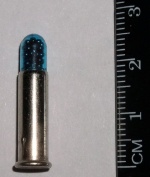
Special .22 LR caliber shot cartridges, usually loaded with #12 shot, have also been made. Called rat-shot for their use in very short range pest control, such rounds have either a longer brass case that is crimped closed, or a translucent plastic "bullet" that contains the shot and shatters upon firing. In specially-made .22 bore shotguns, the shot shells can be used for short range skeet shooting and trap shooting at special, scaled-down, clay targets.
[edit] Full Metal Jacket
During World War II, a full metal jacketed version of the .22 LR was developed for the suppressed High Standard HDM pistol to counter concerns of the legality of using hollowpoint .22 LR bullets in wartime.
[edit] Cartridge length
The .22 LR uses a straight walled case. Depending upon the type and the feed mechanism employed, a firearm which is chambered for .22 LR may also be able to safely chamber and fire the following shorter rimfire cartridges:
The .22 Winchester Magnum Rimfire, also called .22 Magnum or .22 WMR, uses a different case, which has a significant taper and does not use a heeled bullet. Firing a .22 LR or derivative in a .22 WMR firearm will likely result in a potentially dangerous case rupture.
[edit] Usage
Today, .22 LR is mainly being used for hunting small pests, for sports shooting, for plinking, and for cheap training. The .22 LR is the choice for several ISSF shooting events: 50 m Rifle, 50 m Pistol, 25 m Pistol, 25 m Rapid Fire Pistol and 25 m Standard Pistol, Bullseye, plus divisions of metallic silhouette and pin shooting, most high school, collegiate, Boy Scouts of America, Air Training Corps, Australian Army Cadets and 4H shooting events, and many others. In Sweden the .22 LR is used in basic firearms training for Home Guard Cadets. With high quality ammunition, the .22 LR can be quite accurate. Its main advantages are low cost, low recoil, low noise and high accuracy-to-cost ratio. Its main disadvantage is its low power; it is better suited for use on small game and other small animals[5]; as a defensive cartridge, it is considered inadequate, though the small size allows very lightweight, easily concealable handguns which can be carried in circumstances where anything larger would be impractical. Despite their limitations, .22 LR pistols and rifles can be lethal and are often used for self defense simply because they are prevalent, inexpensive, and widely available to civilians.
Semi-automatic rifles firing .22 LR cartridges often will work properly only when firing standard or high velocity .22 LR ammunition; subsonic rounds will often not cycle their actions properly. Bolt-action or lever-action rifles, however, can utilize any of the variants (high velocity to subsonic).
The tiny case of the .22 LR and the subsonic velocities (when using subsonic ammunition) make it well suited for use with a firearm suppressor (also known as silencers or sound moderators). The low volume of powder gases mean that .22 LR surppressor are often no larger than a bull barrel; the Ruger 10/22 and Ruger MK II are common choices, because of their reliability and low cost, and the resulting product is often nearly indistinguishable from a bull barrel model (although weighing far less). Where firearm suppressors are only minimally restricted, a .22 LR firearm with a suppressor is often favored for plinking, as it does not require hearing protection or disturb the neighbors. Local government agencies sometimes use suppressed .22 LR weapons for animal control, since dangerous animals or pests can be dispatched in populated areas without causing undue alarm.
The .22 LR has also seen limited usage by police and military snipers. Its main advantage in this role is its low noise, but it is usually limited to urban operations because of its short range. [6][7]
Intelligence agencies and military special forces have used suppressed .22 LR pistols for assassinations and for eliminating guard dogs or sentries. Some examples include the use of suppressed High Standard HDM pistols by the American OSS, which was the predecessor organization of the CIA. Francis Gary Powers was issued a suppressed High Standard for the flight in which he was shot down. Suppressed Ruger MK II pistols are in current use by the US Navy SEALs.
[edit] Specifications

Muzzle velocity (nominal):
- 40 gr (2.6 g) lead: 1082 ft/s (330 m/s) .22 LR Subsonic
- 36 gr (2.33 g) copper plated lead: 1328 ft/s (405 m/s) .22 LR High Velocity
Note: actual velocities are dependent on many factors, such as barrel length of a given firearm and manufacturer of a given batch of ammunition, and will vary widely in practice. The above velocities are typical.
According to the official C.I.P. guidelines, the .22 LR case can handle up to 205 MPa (30,000 psi) copper crusher (measuring method crusher conformal) pressure. In C.I.P. regulated countries, every rifle cartridge combo has to be proofed at 125% of this maximum C.I.P. pressure to certify for sale to consumers.
[edit] See also
- 5 mm caliber
- Suppressor (Note the sub-section on History, mentioning William Joseph Donovan demonstrating a suppressed .22 to President Roosevelt)
- .22 BB
- .22 Short
- .22 Long
- .22 Magnum
[edit] References
- ↑ [1]
- ↑ Forensic Analysis: Weighing Bullet Lead Evidence 2004 Board on Chemical Sciences and Technology
- ↑ Rimfire Hunting Cartridges Simpson, Layne Petersen's Hunting
- ↑ 4.0 4.1 http://www.chuckhawks.com/17_M2.htm Hornady's New .17 Mach 2] Chuck Hawks
- ↑ Federal Premium: Ballistics Detail Federal Cartridge
- ↑ Ruger 10/22 Suppressed Sniper Rifle
- ↑ SV-99 Sniper Rifle
- C.I.P. decisions, texts and tables (free current C.I.P. CD-ROM version download (ZIP and RAR format))
